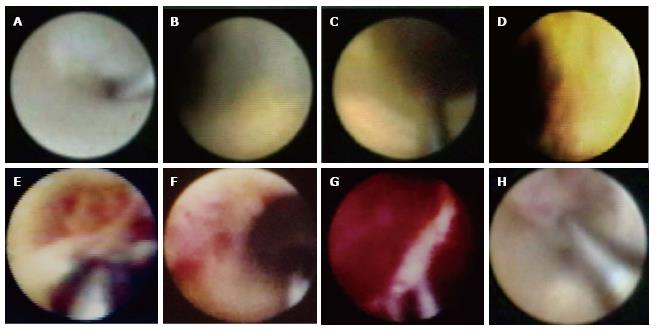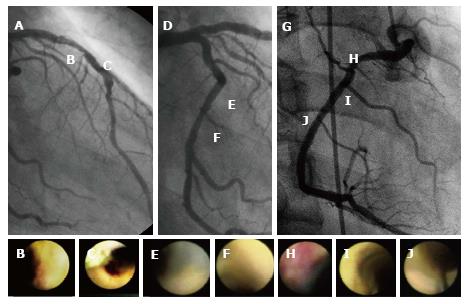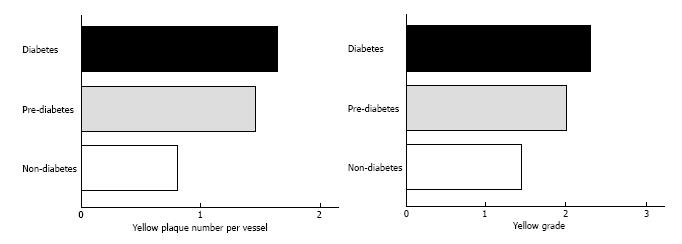Copyright
©The Author(s) 2015.
World J Diabetes. Feb 15, 2015; 6(1): 184-191
Published online Feb 15, 2015. doi: 10.4239/wjd.v6.i1.184
Published online Feb 15, 2015. doi: 10.4239/wjd.v6.i1.184
Figure 1 Classification of coronary angioscopic images.
A: White plaque (yellow grade 0); B: Light yellow plaque (grade 1); C: Yellow plaque (grade 2); D: Intense yellow plaque (grade 3); E: Plaque rupture; F: Plaque erosion; G: Red thrombus; H: White thrombus.
Figure 2 Representative images of nondiabetic patients.
A and B: No angiographic stenosis was observed in the right coronary artery (A), whereas 1 yellow plaque was identified on angioscopy (B). The yellow intensity of these plaques was defined as grade 2; C: The left circumflex artery was too small to observe by coronary angioscopy, and a 75% stenosis was identified on angiography in the middle part of the left ascending artery; D: According to angioscopic findings, this lesion was evaluated as a grade 1 yellow plaque. In this case, the average number of yellow plaques per vessel was 1 (2 yellow plaques in 2 vessels), and the maximum yellow grade per coronary artery was 2.
Figure 3 Representative images of prediabetes patients.
A: A 50% stenosis and a 90% stenosis were identified on angiography in the middle part of the left ascending artery; B and C: According to angioscopic findings, both of these lesions were evaluated as grade 3 yellow plaques; D-F: No angiographic stenosis was observed in the left circumflex artery (D), whereas 2 yellow plaques were defined as grades 1 and 2, respectively (E and F); G-J: Significant stenosis was not observed in the right coronary artery (G), whereas an intramural red thrombus was observed at the proximal site (H), and 3 yellow plaques were identified on angioscopy (H–J). The yellow intensity of these plaques was defined as grades 1, 2, and 1, respectively. In this case, the average number of yellow plaques per vessel was 2.33 (7 yellow plaques in 3 vessels), and the maximum yellow grade per coronary artery was 3.
Figure 4 Representative images of diabetes patients.
A-D: No angiographic stenosis was observed in the right coronary artery (A), whereas 3 yellow plaques were identified on angioscopy (B-D). The yellow intensity of these plaques was defined as grades 2, 1, and 2, respectively; E-G: Significant stenosis was not observed in the left circumflex artery (E), whereas 2 yellow plaques were identified on angioscopy (F and G). The yellow intensity of both of these plaques was evaluated as grade 3 (intense yellow); H: A 50% stenosis and a 90% stenosis were identified on angiography in the middle part of the left ascending artery; I and J: According to angioscopic findings, both these lesions were evaluated as light yellow plaques (grade 1). In this case, the average number of yellow plaques per vessel was 2.33 (7 yellow plaques in 3 vessels), and the maximum yellow grade per coronary artery was 3.
Figure 5 Comparisons of yellow plaque detected by coronary angioscopy among the 3 groups.
A: Average number of yellow plaques per vessel; B: Average maximum yellow grade per coronary artery (MYG). The number of yellow plaques per vessel and maximum yellow grade per coronary artery in the prediabetic group were greater than those in the nondiabetic group (P = 0.017 and P = 0.040, respectively), whereas they were similar to those in the diabetic group (P = 0.44 and P = 0.21, respectively).
- Citation: Kurihara O, Takano M, Seino Y, Shimizu W, Mizuno K. Coronary atherosclerosis is already ongoing in pre-diabetic status: Insight from intravascular imaging modalities. World J Diabetes 2015; 6(1): 184-191
- URL: https://www.wjgnet.com/1948-9358/full/v6/i1/184.htm
- DOI: https://dx.doi.org/10.4239/wjd.v6.i1.184













